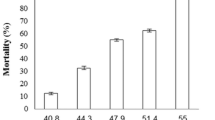Abstract
Chromatographic fractions of Himalayan cedarwood oil (Cedrus deodara) were bioassayed against the pulse beetle (Callosobruchus analis F.) and the housefly (Musca domestica L.). Almost all fractions showed insecticidal activity against both test species. Fractions I and V led to the highest mortality and also produced a quick knockdown effect. Fractions I and V, after rechromatography and purification, yielded himachalol (3%) and β-himachalene (31%), based on essential oil weight, respectively. Further evaluation of these two naturally occurring sesquiterpenes indicated 97.5% mortality at 0.56 μmol/insect against the pulse beetle. These biologically active natural products of plant origin may serve as a suitable prototypes for development of commercial insecticides.
Similar content being viewed by others
References
Abbott, W.S. 1925. A method of computing the effectiveness of an insecticide.J. Econ. Entomol. 18:265–267.
Akhtar, M.S. 1981. Feeding responses to wood and wood extracts byBifiditermes beesoni (Gardner) (Isoptera: Kalotermitidae).Int. Biodeterior. Bull. 17:21–25.
Anonymous. 1950. The wealth of India. A dictionary of Indian raw materials and industrial products. Raw Materials, Vol. II (C). CSIR Publications, New Delhi.
Anonymous. 1985. Perfume repellant.New Sci. 105:21.
Atwal, A.S. 1976. Agricultural Pests of India and South East Asia. Kalyani Publishers, Ludhiana, India. 502 pp.
Balandrin, M.F., Klocke, J.A., Wurtele, E.S., andBollinger, W.H. 1985. Natural plant chemicals: Sources of industrial and medicinal materials,Science 228:1154–1160.
Bhan, P., Pandey, B.S., Soman, R., Damodaran, N.P., andDev, S. 1984. Products active on arthropods-5. Insect juvenile hormone mimics: Sesquiterpene acids having JH activity from the wood ofCedrus deodara Loud.Tetrahedron 40:2961–2965.
Briggs, G.G., Elliott, M., Farnham, A.W., andJanes, N.F. 1974. Structual aspects of the knockdown of pyrethroids.Pestic. Sci. 5:643–649.
Bushland, R.C., 1939. Volatile oils as ovicides for the screwworm,Cochliomyia americana C.J. Econ. Entomol. 32:430–431.
Chen, J.S., Lee, C.J., Yao, M.G., andSun, C.N. 1985. Effect of pyrethroids on knockdown and lack of coordination response of susceptible and resistant diamondback moth (Lepidoptera: Plutellidae).J. Econ. Entomol. 78:1198–1202.
Gigolashvili, L.,Zvinadadze, G.,Gogorishvivili, D.,Labartkava, N., andKanadashvili, M. 1983. The effect of defensive substances of allelopathic plants on some biological indicators of the silkworm,in O.G. Natishvili (ed.),Nauchnye Osnovy Ravitiya Shelkovodstva, pp. 81–90.
Isman, M.B., Yan, J.Y., andProksch, P. 1986. Toxicity of natural chromene derivatives to a grasshopper.Naturwissenschaften 73:500–501.
Joseph, T.C., andDev, S. 1968. Sesquiterpenes XXIX. Structure of himachalene.Tetrahedron 24:3809.
Lloyd, C.J., andParkin, E.A. 1963. Further studies on a pyrethrum-resistant strain of the granary weevil,Sitophilus granarius (L.).J. Sci. Food Agric. 14:655–663.
Matsumura, F. 1980. Toxicology of Insecticides. Plenum Press, New York.
Saxena, B.P., andKoul, O. 1978. Utilization of essential oils for insect control (review).Indian Perfumer 22:139–149.
Sen-Sharma, P.K. 1963. Studies on the natural resistance of timbers to termites.Indian For. Bull. 220:10 pp.
Singh, D., andRao, S.M. 1986. Effect of cedarwood oil on reproduction ofDysdercus koenigii (F.)Current Sci. 55:422–423.
Singh, D., andRao, S.M., andTripathi, A.K. 1984. Cedarwood oil as a potential insecticidal agent against mosquitoes.Naturwissenschaften 71:265–266.
Author information
Authors and Affiliations
Additional information
CIMAP Publication No. 598.
Rights and permissions
About this article
Cite this article
Singh, D., Agarwal, S.K. Himachalol andβ-himachalene: Insecticidal principles of himalayan cedarwood oil. J Chem Ecol 14, 1145–1151 (1988). https://doi.org/10.1007/BF01019342
Received:
Accepted:
Issue Date:
DOI: https://doi.org/10.1007/BF01019342




